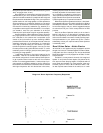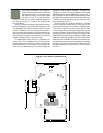
established now that dead flat 20 kHz treble
response in your room is an unpleasant expe-
rience. I’m not sure if that’s because 20 kHz flat
is just too much treble or too much distorted
treble. I find that treble distortions are the
most pernicious throughout the entire chain from recordings
to speakers. The Salon’s treble seems well balanced as a part
of the musical whole. I do, though, hear slight treble limita-
tions within the highest harmonic structures of instruments.
But I wouldn’t want more treble extension if it meant that
I had to sacrifice even one other positive characteristic of the
Salon. The Salon seems almost uniquely well crafted to repro-
duce musical timbres. It has the best balance of tonality and
character of any speaker I have ever used. In this regard, it is
our noble warrior against the ancient enemy.
The Salon is a four-way design with crossover points at
125 Hz, 450 Hz, and 2.2 kHz. All crossovers are fourth order
Linkwitz-Riley. Three 8-inch mica/carbon-filled polymer dome
woofers handle the range below 125 Hz. These woofers are
said to extend the Salon’s bass response to a minus 10dB
point at 17 Hz. The midbass driver, which actually handles the
upper bass through lower midrange, is a 6.5-inch driver of the
same composition as the woofers. The midrange driver is a 4-
inch titanium dome. The Salon has two tweeters. One, which
is more robustly built of an aluminum alloy, fires forward
while the other fires back, to provide ambient fill in the high-
er frequencies. Except for the tweeters, the Salon drivers are
designed and made within the Harman International house
(likewise for the 15-inch woofer in the Sub-15).
The design brief for the drivers included the ability to han-
dle high peak amplitudes without compression. This was nec-
essary to achieve the Revel design team’s (led by Kevin
Voecks) objectives, since they wanted a speaker that would
not change tonal character on dynamic peaks.
Nearly every aspect of the Salon’s design and perfor-
mance can be related to Revel’s primary objective – to pro-
duce a speaker as timbrally accurate in the listening room as
it is in the lab. To that end, Revel embarked on an extensive
research effort to quantify in-room speaker behavior and
incorporate its findings in its speaker designs. The typical lis-
tening room undermines many speaker designs, which boast
nonpareil frequency response when measured anechoically.
Typically, the upper bass and lower midrange are suppressed,
exaggerating the upper midrange and lower treble content. To
combat this, Revel developed a model of what a typical lis-
tening room does to a loudspeaker’s frequency response.
It is ironic how so many of the virtues we prize in sound –
midrange openness, soundstage depth, and detail resolution –
are exaggerated by the colorations created by the room-loud-
speaker interface. Many might regard these characteristics as
indicators of “transparency,” since they artificially open up
the soundstage and highlight the transient details of images.
In this context, the Salon can come as a bit of a shock. It
sounds fuller than many other loudspeakers. Further, its
sound is more up front spatially (not timbrally) and it doesn’t
seem, at first listen, to resolve as much information. It doesn’t
take long, though, to realize that the Salon is telling a higher
truth. In contrast with most other speakers, it is capable of
rendering timbres that are more fully saturated. That is,
instrumental timbres sound more authoritative and more
complex. There is a legitimate weight to the sound of instru-
ments through the Salon that is natural sounding and intoxi-
cating. Consider, for example, the ride cymbal front and cen-
ter at the start of the Conspiracy Theory soundtrack [TVT
8130-2]. Through the Salons, it is possible to hear the sus-
tained fundamental in the instrument’s metal while the sizzle
rides cleanly in the overtones. There is richness here that is
often missing, and yet the textural aspect of the instrument’s
timbre is not lost (as it would be with another rich sounding
type of component – the single-ended triode amplifier). I sus-
pect that the Revel’s ability to project power into the room in
the lower midrange through upper bass is directly related to
its wonderful way with timbres. Don’t forget that this is the
region where most fundamentals reside. Reduce the strength
of the fundamentals and lower harmonics in a note and the
result will be washed out timbre.
There are a number of loudspeakers based on the legacy
of Allison’s work in room acoustics that reproduce timbre
much like the Revel. While I haven’t heard all of these, my
impression is that the Revel distinguishes itself by maintain-
ing its tonal balance more evenly at all loudness levels. Dur-
ing major dynamic peaks, the Salons don’t compress nearly as
much as most speakers I have heard. Thus, their tonality
doesn’t change. Moreover, the treble distortion is truly mini-
mal during such peaks – movie lovers will drop to their knees
to thank Revel.
A c t u a l l y, mentioning the single-ended triode amplifier
makes me wonder – did music lovers turn to that flawed
device in an effort to restore the timbral richness that was
lost in their rooms by many loudspeakers? If so, the solid-
state amplifier is going to experience a perception makeover
when paired with the Salon, because listeners will be able to
enjoy solid-state control with timbral accuracy. I have, with
a wide variety of solid-state amps (the BEL 1001 Mk IV, the
Proceed HPA 3, and the Conrad-Johnson Design MF-5600).
You will want to use a sizable solid-state amp with the Salon.
Its sensitivity is moderate at 86 dB with 2.83 volts input and
its minimum impedance is 3 ohms (nominal: 6 ohms). This
i s n ’t a hideous load, but a robustly designed solid-state
amplifier with low output impedance will pay dividends. Do
not assume, though, that the Salon is imposing a pleasant-
sounding distortion through the lower midrange that makes
these different amplifiers all sound alike – the Salon can dif-
ferentiate the sound of amplifiers and source components
quite easily. In this respect it is a reviewer’s dream – reveal-
ing sound that is also a delight to hear.
When optimally set up, the Salons easily reached into
the 20 Hz region, producing clean bass information that I
could feel in my chest. It clearly delineated the plethora of
big instruments on Conspiracy Theory. The Salon sports a
bass control that allows the listener to reduce or boost the
bass in the region around 50 Hz. This proved helpful in my
room, as I was able to reduce the effect of the 50 Hz node
(take t h a t ! cursed Room).
Although the Salon’s balance through the lower and
middle frequencies seems to bring images forward, it still
produces a remarkable soundstage with stunning resolution
in the field of depth. This soundstaging performance is
unique among the direct-radiating dynamic-coil designs I
have experienced. Many direct radiators produce pinpoint
images within a smaller, sharply defined soundstage. In con-
trast, the presentation of dipole radiators is more open.
Dipole images, depending on the design, can range from
well-focused (though typically not as tightly focused as a


















